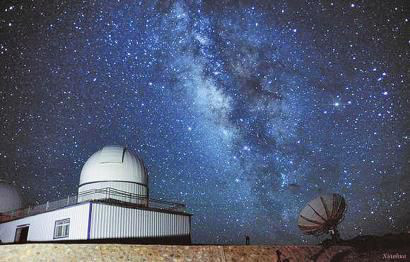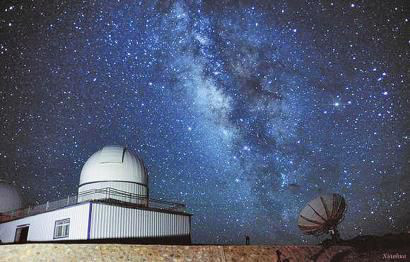By Bai Yang from People’s Daily

The Ngari Observatory (Photo from Jinan Daily)
China is under smooth progress towards the world's highest altitude gravitational wave telescopes in Tibet Autonomous Region to detect the faintest echoes resonating from the universe, a project insider disclosed.
The main part for the first stage of the “Ngari plan”, which was launched by China in March 2017 to eyeball the Big Bang cosmic waves at Ngari, Tibet, is almost completed, Zhang Xinmin, chief scientist of the project said on the sidelines of the ongoing first session of the 13th National Committee of the Chinese People’s Political Consultative Conference (CPPCC).
The project will start operations in 2020 and observation results will arise in 2022, added Zhang, a senior researcher at the Institute of High Energy Physics in the Chinese Academy of Sciences (CAS).
At the first stage of the two-phased project, a telescope code-named Ngari No.1 would be constructed at 5,250 meters above sea level to enable the first measurement of primordial gravitational waves in the northern hemisphere, according to the scientist.
The first telescope is expected to be installed at the end of 2019 and operational in 2020, added Zhang, also a member of the 13th CPPCC National Committee.
The second stage, according to him, involves a series of telescopes, code-named Ngari No. 2, to be located at an altitude of about 6,000 meters, to realize more accurate measurement of the waves.
Chinese scientists are now working on design of the first telescope with a team of Stanford University, and they would cooperate more in the future, he said.
The primordial gravitational waves, different from gravitational waves produced by motions and evolution of the heavenly bodies, were generated by the first tremors of the Big Bang.
Detection of the primordial gravitational waves is of great significance to studying the origin and evolution of the universe, said Zhang.
Ngari is considered as one of the world's four best places for astronomers to gaze into the faint echoes from the earliest days of the universe given its thin air, clear skies and minimal human activity.
The other three spots to detect the tiny twists in cosmic light are Atacama Desert, Chile and Antarctica in the southern hemisphere, as well as Greenland in the northern hemisphere.
The Ngari observatory, once constructed, will be the first of its kind in the northern hemisphere for China to carry out experiments regarding detection of primordial gravitational waves.
By then, the Ngari observatory, alongside the existing South Pole Telescope and the facility in Chile’s Atacama Desert, will cover both the northern and southern hemispheres.
Both space exploration and ground-based research have been employed by China to gaze into the remote universe.
The telescope in Ngari and FAST, a 500-meter aperture spherical radio telescope in southwest China’s Guizhou province, dedicate to probing waves from ground-based research facilities, while the Taiji and Tianqin projects, proposed by CAS and Sun Yat-sen University respectively, focus on detection by launch of satellites.
The main part for the first stage of the “Ngari plan”, which was launched by China in March 2017 to eyeball the Big Bang cosmic waves at Ngari, Tibet, is almost completed, Zhang Xinmin, chief scientist of the project said on the sidelines of the ongoing first session of the 13th National Committee of the Chinese People’s Political Consultative Conference (CPPCC).
The project will start operations in 2020 and observation results will arise in 2022, added Zhang, a senior researcher at the Institute of High Energy Physics in the Chinese Academy of Sciences (CAS).
At the first stage of the two-phased project, a telescope code-named Ngari No.1 would be constructed at 5,250 meters above sea level to enable the first measurement of primordial gravitational waves in the northern hemisphere, according to the scientist.
The first telescope is expected to be installed at the end of 2019 and operational in 2020, added Zhang, also a member of the 13th CPPCC National Committee.
The second stage, according to him, involves a series of telescopes, code-named Ngari No. 2, to be located at an altitude of about 6,000 meters, to realize more accurate measurement of the waves.
Chinese scientists are now working on design of the first telescope with a team of Stanford University, and they would cooperate more in the future, he said.
The primordial gravitational waves, different from gravitational waves produced by motions and evolution of the heavenly bodies, were generated by the first tremors of the Big Bang.
Detection of the primordial gravitational waves is of great significance to studying the origin and evolution of the universe, said Zhang.
Ngari is considered as one of the world's four best places for astronomers to gaze into the faint echoes from the earliest days of the universe given its thin air, clear skies and minimal human activity.
The other three spots to detect the tiny twists in cosmic light are Atacama Desert, Chile and Antarctica in the southern hemisphere, as well as Greenland in the northern hemisphere.
The Ngari observatory, once constructed, will be the first of its kind in the northern hemisphere for China to carry out experiments regarding detection of primordial gravitational waves.
By then, the Ngari observatory, alongside the existing South Pole Telescope and the facility in Chile’s Atacama Desert, will cover both the northern and southern hemispheres.
Both space exploration and ground-based research have been employed by China to gaze into the remote universe.
The telescope in Ngari and FAST, a 500-meter aperture spherical radio telescope in southwest China’s Guizhou province, dedicate to probing waves from ground-based research facilities, while the Taiji and Tianqin projects, proposed by CAS and Sun Yat-sen University respectively, focus on detection by launch of satellites.
 Menu
Menu
 Construction of gravitational wave telescopes in Tibet underway
Construction of gravitational wave telescopes in Tibet underway
















